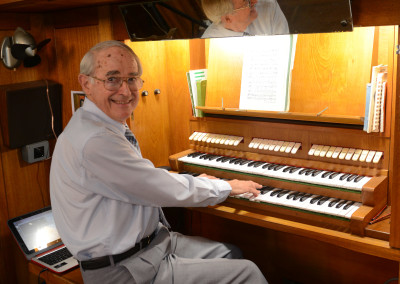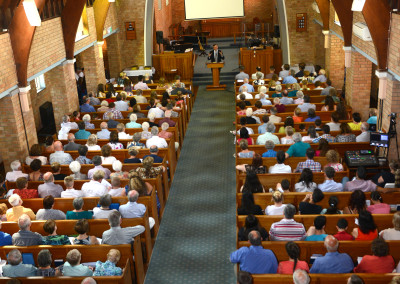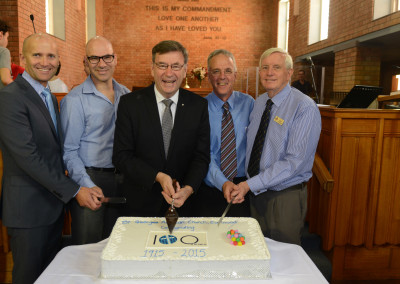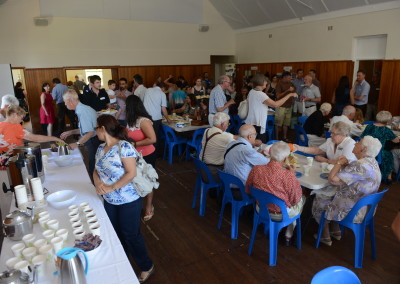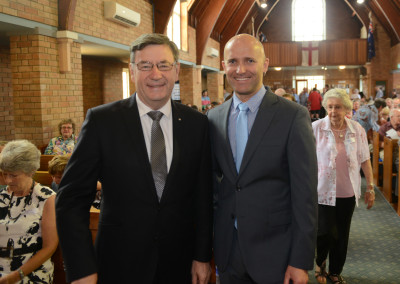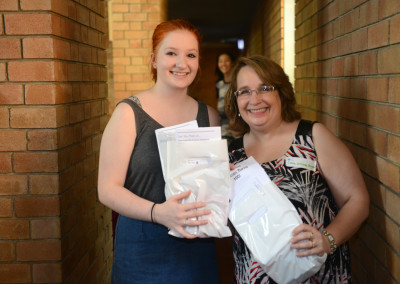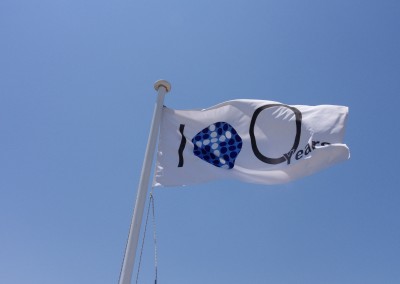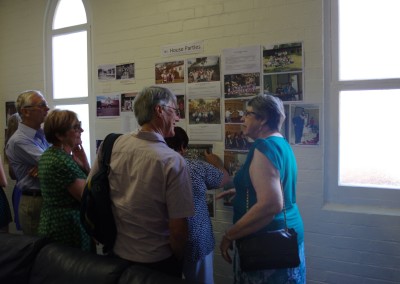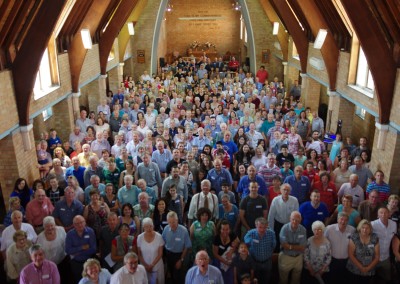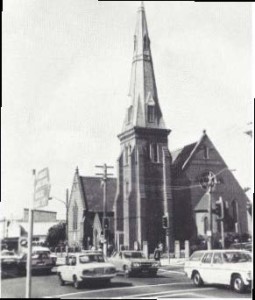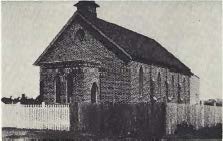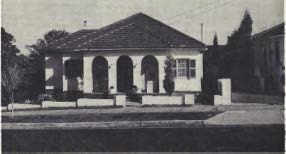
Years!
In December 2015 Earlwood Anglican turned 100 years old and we certainly didn’t sit back and let this occasion go uncelebrated, we took advantage of the anniversary by celebrating it with a great community of parishioners past and present with a combined service of over 300 people. God Be Praised!
Have a look at some of the great photos from the day.
“The church is about people and the way God
has used them. The work of the ten clergymen who
have ministered in Earlwood can never adequately be
assessed, nor can the contribution, made by hundreds
of lay people who have worked faithfully in this place
in the past and present. The “real” history and significance
of this parish is to be found in the hearts of
men and women, “written not with ink but with the
Spirit of the living God.”
ROBERT JONES
A HISTORY OF ST. GEORGE’S
EARL WOOD
Compiled by Rev. Robert Jones
Rector of Earlwood
(This History was originally Published by the Authority of the Parish Council on the occasion of the 25th Anniversary of the opening and
Dedication of St. George’s Parish Church)
St. Clement’s Marrickville Earlwood was
part of Marrickville Parish from 1915 – 1926
FOREWORD
The history of the parish of St. George’s Earlwood
covers only sixty-five years, It is young compared
to many Sydney parishes, and its history is far
from outstanding. It is a very ordinary parish.
This is the first time St. George’s history has been
compiled. Most of the material has come from parish
records at Marrickville and Earlwood, together with
some personal reminiscences from older parishioners.
This history deals mainly with the buildings at St.
George’s and how they have come to take their
present form. Names of certain people are mentioned
but it is not a history that attempts to assess the
contribution that many people have made over these
past sixty-five years. This history is, therefore very
limited in its scope.
The church is about people and the way God
has used them. The work of the ten clergymen who
have ministered in Earlwood can never adequately be
assessed, nor can the contribution, made by hundreds
of lay people who have worked faithfully in this place
in the past and present. The “real” history and significance
of this parish is to be found in the hearts of
men and women, “written not with ink but with the
Spirit of the living God.”
ROBERT JONES
Rector of St. George’s
The suburb of Earlwood is one of the most recent centres developed within the Municipality of Canterbury. It has had three names in its short history: first, “Parkestown,” after the family of one of the original land grantees, John Parkes; later, “Forest Hill,” from the dense forest covering the ridge on which the suburb is built; and about the beginning of this century, “Earlwood.”
The first recorded use of the name “Earlwood” seems to be on a subdivision plan of the land bounded by Homer Street, Morgan Street, Wolli Creek, and Richard Avenue, offered for auction sale in 1905. This land was owned by Mrs. Jane Earl in 1883 and subdivided under the name of “The Earlwood Estate.” It is probable that the developers settled on the name of Mrs. Earl, as previous owner, and a variation on “forest,” that is “wood” to describe the lush vegetation as an attraction to buyers.
The term proved popular in the district and was eventually used in 1918 as the suburb’s official name.
In 1915 the Mission Church of St. George’s, Earlwood was opened, and is probably the oldest public institution still existing on its original site in Earlwood. (The Earlwood Public school was opened in 1916; the Methodist (Uniting) Church in 1922; the Roman Catholic Church in 1922; the Salvation Army in 1925; the Presbyterian Church in 1926; the Baptist Church in 1928; the Church of Christ in 1932). For the first eleven years of its history, St. George’s was a branch church of St. Clement’s Marrickville. In 1915 St. Clement’s was a large thriving parish, with two branch churches (St. Andrew’s, Victoria Road, and St. Mark’s, West Marrickville) and a Sunday School hall at the Warren.
The Rector at this time was Canon William Martin, who was assisted by two curates, Rev. F. W. Tugwell, and Rev. T. Hughes. The building of the first St. George’s came about in the following way. In April 1915 a letter was received by the Rector of St. Clement’s from the Archbishop of Sydney, Dr. John Charles Wright in which he sought the approval of the Vestry of St. Clement’s to extend their parish boundaries. The new area was to extend from the Cook’s River to Thompson Street, to William Street, and along William Street and Illawarra Road back to the River; in other words, the area known then as Undercliffe.
At the Easter Vestry Meeting, held in St. Clement’s Parish Hall on Tuesday evening, 13th April, 1915, Canon Martin (later Archdeacon) spoke of the proposed extension of the Marrickville Parish boundaries as outlined in the Archbishop’s letter. He reported that he and his colleagues (Messrs. Tugwell and Hughes) had visited the area and “found there was much ground to be possessed and a good work to be done in the future, and it was therefore very necessary that something should be done at once in the direction indicated.”
The Canon went on to speak, at some length, of the advisability of extending the parish northward, and explained that land would have to be purchased and a small building erected, but he assured the meeting it would be money well spent. The curates also spoke of the number of people residing in the area, who were “crying out for services to be established,” and that the area was developing rapidly. Mr. Tugwell then proposed that “The Archbishop’s proposal to take over Undercliffe be accepted and that the Church Wardens be given the necessary authority to proceed with the necessary work.”
The resolution, on being put, was carried unanimously. With surprising speed the necessary work of purchasing land and building was carried out. By 22nd July, 1915 it was reported at a special vestry meeting that the purchase of the land at Undercliffe had been finally fixed, and the suggestion was made that the erection of the school hall should proceed with urgency owing to an anticipated increase in building materials! A plan and specification were prepared, and the tender of Cree and Dedman for the building of the school hall was accepted at £475, with an added £30 for contingencies should they arise. Money for the project was raised by debentures from parishioners of St. Clement’s with an interest rate of 4%.
The following article appeared in the St. Clement’s Parish Notes of August, 1915. “NEW CHURCH – Undercliffe Heights. A site 100 feet by 139 feet has been secured on the Minnamorra Estate, off Homer Street and near Wardell Road. It is a good and central position. The Canon and his two colleagues have visited every house in the district, and found everywhere people glad to hear that a Church was soon to be erected. On Wednesday, July 21st a meeting was held of the people in the district at the house of Mr. Amos, who very kindly placed his dining room at the disposal of the Canon for the meetjng, or any subsequent meeting which might be needed before the School Church is erected.”
Mrs. E. MacDonald of Richmont St. who was born 81 years ago in Earlwood at her parents home in Richard Avenue, and still lives in Earlwood, recalls that her parents owned a pig and poultry farm on Wolli Creek and that her father and some of her brothers helped clear the land on which St. George’s is built, and carted some of the saplings back to the farm for fire-wood. Rev. R. P. Gee, Jay reader to St. George’s 1915-20, recalls, “My earliest recollection of St. George’s is the invitation by the late Archdeacon W. Martin for parishioners to attend the laying of the Foundation Stone of a new church at Earlwood. I attended this Service, and remember that several churchmen of St. Clement’s bought blocks of land on either side of the Church block to be held by them until the church required them for further expansion. For several weeks following, a number of young people from St. Clement’s went for a Sunday afternoon walk to see the progress of the building.”
St. George’s Mission Hall, Earlwood – opened in December, 1915
Work progressed so rapidly that in October it was reported that the work on the building would be completed by mid-December. At around the same time the government had been carrying out survey operations in Undercliffe, with the view to extending the tram line from Cooks River. It was anticipated that when the tram line was extended it would mean a great increase in population for . the area, and a still greater demand for the church. (The tram line extension was not completed until •1924). By 30th November the Canon reported that all the arrangements had been made for the opening of the Mission Hall at Undercliffe by the Archbishop on Saturday, 18th December at 3.30 p.m.
The church was to be called “St. George’s.” At the same meeting the Canon announced that the Archbishop had conferred the honour of Archdeacon upon him.
The opening and dedication of St. George’s Mission Hall was held on the appointed time and day, Archbishop John Charles Wright performing the ceremony, assisted by Archdeacon Martin. Other clergy present were Canon A. Bellingham (the previous Rector of Marrickville), Rev. F. Tugwell (curate) and Rev. T. Hughes (curate). Mr. Walter Newell, the honorary lay reader, and the Church wardens of Marrickville: Messrs. S. H. Ricking, W. H. Wicks, and W. A. Cains were also present, together with many parishioners from St. Clement’s. The building was described as . . . “a grand little brick and stone church with a beautiful situation. Roughly speaking, the church and land has cost £1,000. The size of the building is 55 feet by 27 feet, and is capable of seating about 200 people.” It was also noted that “the building of the church during war time was a venture of faith. The Vestry (of Marrickville) thought well over the matter; the wardens were entirely with the Rector, and so the church has been built. It will shortly be the centre of a great district. Such a healthy and picturesque spot will not be left long unpeopled.”
On the day following the opening, the first services were held. At 11.00 a.m. Mr. Reginald Gee, lay-reader, read Morning Prayer, and Mr. Charles Farrow,. senior lay-reader at St. Clement’s read the lessons and preached the sermon. The offertory was 6/6. At 7.15 p.m. Mr. Gee again read the service and Archdeacon Martin preached. The offertory was £1/9/0. A week later, at the first Christmas day service, the Holy Communion was celebrated by Rev. F. Tugwell, who also preached. Mr. Gee again assisted at the service at which there were nine communicants, and an offertory of 8/ 5.
Notable amongst the personel connected with St. George’s in those early days were: Mr. Charles Farrow, who was appointed the first Sunday School Superintendent and who regularly preached at 11.00 a.m. service.
Mr. Reginald Gee, who regularly read the morning and evening services for the next five years. Rev. R. B. Robinson from St. Barnabas’ Broadway who was appointed by the Archbishop to assist in the parish of Marrickville on Sunday evenings and Thursdays and Fridays because of the claims on the Rector’s time as Archdeacon.
This was a temporary appointment, until permanent arrangements could be made, but Mr. Robinson continued in his work in the parish until May, 1917. He had special responsibilities to do evangelistic work in the Undercliffe area.
The first district visitors in Earlwood were:
,Mrs. Amos – Homer Street, from Wardell Road to Unwins Bridge Road. Mrs. Faulkes – Homer Street, from Wardell Road to William Street. Mrs. Ward – All houses off the main road. Mrs. Collins – William Street.
The years 1916-1926 were busy years for the Earlwood area of the Marrickville parish. The church was involved in many activities, and Sales of Work and Concerts organised by the ladies of the congregation and the Sunday School feature prominently. Organisations such as the Mothers Union, the Young Men’s Union, and the Boys’ Choir all made their appearances at St. George’s. So did a preparatory school for children aged between 5-10 years. But by far the most encouraging work during these years and for many years to come, was that of the Sunday School, which soon numbered in the vicinity of two hundred children.
In regard to the work of the Sunday School, Mr. Gee wrote:
“We decided to open a Sunday School in the afternoon, and we brought our lunch over, boiling a billy for our tea in a fireplace of old bricks behind the (church) building. As the numbers of scholars increased, several young men from St. Clement’s Men’s Bible Class came to assist as teachers. Later on, several local people replaced these men, most of whom enlisted for service overseas. The sanctuary of the building was screened off to enable us to hold meetings and social functions. Gradually the grounds were cleared and also the scrub around the church to reduce the fire hazard. On Sundays, I walked from the river bridge at the end of Wardell Road through the scrub, following a line of poles carrying telephone wires, up the top road near the Church.”
During these years, a succession of curates from St. Clement’s were given special care of the Earlwood area of the parish. Rev. L. Gabbott was licensed as the curate of Marrickville and curate-incharge of the conventional district of Earlwood in July, 1917. He worked in the Earlwood district until he resigned on 30th June, 1920 to take up an appointment in the parish of Suspension Bridge (Northbridge).
Rev. A. A. W. Connolly took over from Mr. Gabbott as the senior curate of Marrickville having previously been rector of St. Andrew’s Mayfield, Newcastle.
When Mr. Connolly resigned on 31st October, 1922, he became rector of Gordon. Because a second curate could not be obtained after Mr. Connolly’s resignation, the services were obtained of Mr. E. Graham, a lay reader from William Street, St. Peter’s, and he worked in Earlwood from 1st January, 1923.
On 17th May, 1923 at the monthly meeting of St. George’s Men’s Committee a lengthy report was presented by the secretary Mr. Lassau and the treasurer Mr. Twigg in which they pointed out the general decline in church attendance and finances compared to previous years. They put this down to the fact that here was no regular preacher, the majority of services being taken by catechists. An improvement had been noticed since the regular attendance of Mr. Graham in the parish, but they stressed the need for a resident clergyman. Mr. 0. J. Matthew’s, church warden at St. Clement’s also addressed the meeting “during which he pointed out the great benefits to be derived from having a resident minister; at the same time predicting a great future for St. George’s as an independant parish.”
The services of a second curate were obtained when Rev. L. G. Edmondson was licensed as curate of Marrickville on 28th January, 1924. This enabled the senior curate, Rev. R. J. Hewett to take over the work in the Earlwood part of the parish but on 31st August, that same year Mr. Hewett resigned the curacy to take up an appointment as deputy secretary of the Church Missionary Society. Mr. Edmondson was then placed in charge of the work at Earlwood, and the work progressed rapidly. By March, 1925 it was reported that “congregations at the morning services are greatly improved.” By the end of the year a committee of men and women was formed to assist Mr. Edmondson in devising ways and means for the development of the church life.
It was finally decided by Archdeacon Martin that, from 1st April, 1926, Mr. Edmondson should live in Earlwood (formerly he had lived at 353 Marrickville Road) and take over the work completely. From that date on the people of St. George’s Earlwood were responsible for all expenses connected with the work of their church. In the Wardens report at the Easter Vestry Meeting of Marrickville a comment was made on Rev. and Mrs. Edmondson’s leaving to take over the Earlwood District:
“Earlwood is a growing district, and in time will be a most important and flourishing parish. It is fortunate that Archdeacon Martin, and the Wardens, years ago, secured land for the church, school, and rectory. The Church School was built by money advanced by St. Clement’s. This land, together with the school church is worth probably £2,000, and the debt on the same is small, so the people of Earlwood have a good start.”
The Rev. L. G. Edmondson was licensed as Curate in. Charge
of the Conventional District of Earlwood on 9th November, 1926.
The present Rectory was built in 1928
